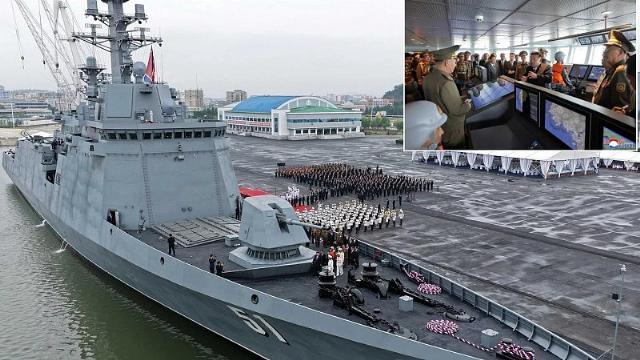North Korea has announced that its newest destroyer, the Choi Hyun, is ready for deployment, indicating a significant expansion of its naval capabilities. This move underscores Pyongyang's intention to project power and counter the forces of the United States and its allies at sea, Navy Recognition notes.
North Korean media reported that Kim Jong-un visited the Choe Hyun destroyer and called it ready for deployment. This modern warship, designed to operate far beyond the coastal waters of North Korea, represents a leap in the development of Pyongyang's naval capabilities.

Destroyer Choi Hyun, North Korea
Defence Index
With an estimated displacement of approximately 5,000 to 5,500 tons, the Choe Hyun represents a significant step forward compared to the outdated Soviet frigates and corvettes that have been the backbone of the North Korean navy for decades. An analysis of the design based on satellite images indicates that the destroyer has a two–deck superstructure, an effective scattering area that ensures stealth, and at least two multi-cell vertical launch units - one in the bow and one in the stern, which potentially allows for the placement of 64 to 76 missiles.
Officially, information about the composition of the weapons has not been disclosed. The presence of vertical launch systems suggests compatibility with North Korean cruise missiles KN-27 or Hwasal-2, with a range exceeding 1,500 km. Such an arsenal would allow the Choi Hyun to hit targets in Japan, South Korea, and even American bases on Guam that are under threat from international waters, without the need to fly through missile defense corridors.
Naval analysts have found at least one North Korean-designed CIWS-type melee system, very similar to the Russian AK-630, mounted on the upper decks. The main gun, presumably a 127-mm naval cannon, provides the ability to engage surface targets and fire at coastal targets.
Navy Recognition journalists believe that the Choi Hyun is designed as a multi-purpose guided missile destroyer combining anti-aircraft, anti-ship and anti-submarine warfare capabilities.
The energy system remains one of the most obscure features of the new class of ships. North Korea has no experience in developing high-performance offshore turbines, so most observers believe that the destroyer is probably equipped with a conventional diesel power plant. This will limit the range and speed, but will not prevent the ship from conducting patrols in regional waters, especially in the Japan and East China Seas, and possibly in more distant areas when refueling from support vessels.
For South Korea and Japan, the deployment of a large surface ship with a strategic strike capability requires a rethink of the maritime security doctrine. Equipped with the Aegis system, Japanese destroyers and South Korean KDX-III are technically capable of tracking and intercepting cruise missiles, but real-time targeting and the ability to confirm the threat before launch remain serious obstacles.
For the United States, the commissioning of a new generation North Korean destroyer introduces a new variable in naval planning in the Indo-Pacific region. The U.S. Navy's 7th Fleet, headquartered in Yokosuka, Japan, relies heavily on freedom of navigation, patrols, and the operational superiority of carrier strike groups and amphibious ship formations. A North Korean destroyer armed with cruise missiles to attack ground targets can pose a threat to vulnerable targets in the theater of operations, including logistics centers, advanced airfields and naval facilities, thereby serving as a deterrent without the need for a direct clash with American forces.
